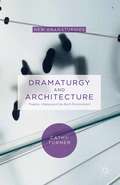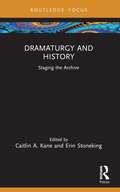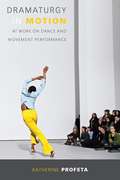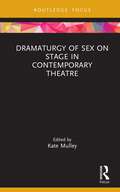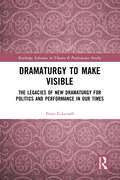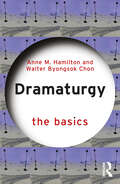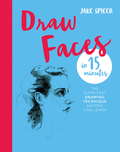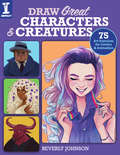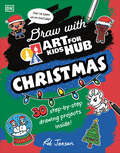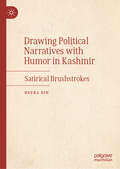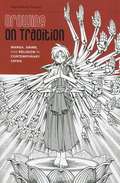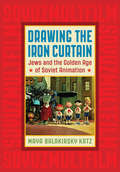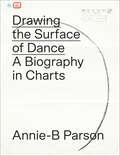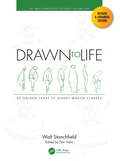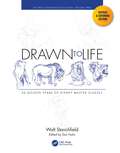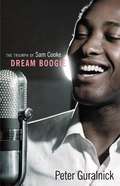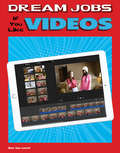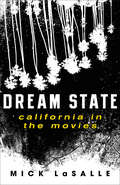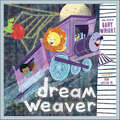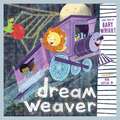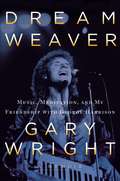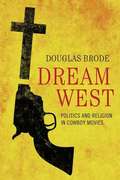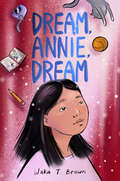- Table View
- List View
Dramaturgy and Architecture: Theatre, Utopia and the Built Environment (New Dramaturgies)
by Cathy TurnerDramaturgy and Architecture approaches modern and postmodern theatre's contribution to the way we think about the buildings and spaces we inhabit. It discusses in detail ways in which theatre and performance have critiqued and intervened in everyday spaces, modelled our dreams or fears and made proposals for the future.
Dramaturgy and History: Staging the Archive (ISSN)
by Caitlin A. Kane Erin StonekingDramaturgy and History provides a practical account of an aspect of dramaturgical practice that is often taken for granted: dramaturgs’ engagements with history and historiography.Dramaturgs play a vital role in amplifying and activating theatre’s unique potential to contribute to the pressing public discourse around the uses and legacies of history.This collection challenges the notion of history as an unassailable or settled set of facts, offering readers a glimpse into the processes and methods of eighteen dramaturgs working in a variety of settings, including professional theatres, universities, museums, and archives. The dramaturgs featured use history to a variety of ends: they reframe classical texts for contemporary audiences; advocate for the production of lesser-known writers and the expansion of the canon; create new works that bring women’s, LGBTQIA+, and Global Majority histories to life; and establish new and necessary archives by/of/for minoritarian artists. Collectively, they examine and animate some of the most urgent questions, concerns, and challenges that dramaturgs encounter in working with history.An essential resource for teachers and students of dramaturgy, the collection offers a concluding hands-on exercise for each chapter to facilitate the reader’s application of the methods discussed in their own practice.
Dramaturgy in Motion
by Katherine ProfetaDramaturgy in Motion innovatively examines the work of the dramaturg in contemporary dance and movement performance. Katherine Profeta, a working dramaturg for more than fifteen years, shifts the focus from asking "Who is the dramaturg?" to "What does the dramaturg think about?" Profeta explores five arenas for the dramaturg's attention--text and language, research, audience, movement, and interculturalism. Drawing on her extended collaboration with choreographer and visual artist Ralph Lemon, she grounds her thinking in actual rehearsal-room examples and situates practice within theoretical discourse about contemporary dramaturgy. Moving between theory and practice, word and movement, question and answer until these distinctions blur, she develops the foundational concept of dramaturgical labor as a quality of motion. Dramaturgy in Motion will be invaluable to practitioners and scholars interested in the processes of creating contemporary dance and movement performance--particularly artists wondering what it might be like to collaborate with a dramaturg and dramaturgs wondering what it might be like to collaborate on movement performance. The book will also appeal to those intrigued by the work of Lemon and his collaborators, to which Profeta turns repeatedly to unfold the thorny questions and rich benefits of dramaturgical labor.
Dramaturgy of Sex on Stage in Contemporary Theatre (Focus on Dramaturgy)
by Kate MulleyDramaturgy of Sex on Stage in Contemporary Theatre explores the dramaturgy of sex in contemporary works for the stage in the social, cultural and historical context of the time and place during which they were written and performed. Comprising chapters by writers from across North America and Europe, the book covers an expansive range of plays, musicals and dance performances, from Broadway to the Fringe, from post-AIDS epidemic to post-COVID-19 pandemic. Analysing these intimate moments—both textually and as staged—through an intersectional and critical lens illuminates the way power structures are maintained and codified, and how they can be queered and dismantled onstage and off. This examination of depictions of sex on stage attempts to understand from a dramaturgical and sociological perspective how these depictions have developed over time, and how the rise of intimacy directors has responded to the changes within the contemporary theatrical landscape and in the world at large. This is an essential companion for any scholar or practitioner looking to stage, discuss or understand intimacy in performance.
Dramaturgy to Make Visible: The Legacies of New Dramaturgy for Politics and Performance in Our Times (ISSN)
by Peter EckersallThis book argues that dramaturgy makes things visible and does so in two distinct and interrelating ways: creative processes and formal elements of performance are rendered visible and readable; and performance dramaturgy becomes an expanded practice in which performance is a locus for creating wide-ranging events and activities.This exploration defines dramaturgy as a perceptibly transforming agency in the construction, presentation and reception of contemporary performance; and it shows how contemporary performance has an intrinsic dramaturgical aspect whose proliferation of dramaturgical practices has led to a far-reaching reinvention of what contemporary theatre is. In doing so, this book deals with a careful selection of performance practices, including theatrical adaptations, new media dramaturgy, contemporary dance, installation-performance, postdramatic theatre, visionary works by auteurs, and revivals of well-known stage shows.This study will be of great interest to students and scholars in theater studies, performance studies, cultural studies, curating, and dance scholarship.
Dramaturgy: The Basics (The Basics)
by Anne M. Hamilton Walter Byongsok ChonDramaturgy: The Basics introduces the art of dramaturgy, explaining how dramaturgy works, what a dramaturg is, and how to appreciate their unique contribution to theatre-making. A wide-ranging account of the role of this vital element of theatre helps students and aspiring performance makers to apply dramaturgy to a full spectrum of theatrical disciplines. This guidebook teaches dramatic theories and script analysis as essential skills for aspiring dramaturgs and illustrates the various methods of reading for specific functions of dramaturgy. Dramaturgy: The Basics offers practical step-by-step instructions on how to practice production dramaturgy, dramaturgy of new work, translation, adaptation, devised theatre, site-specific theatre, literary management, criticism, editing, producing, and dramaturgical innovation, with detailed questions to consider at each stage of the process. This book aims to help students develop a dramaturgical mindset, enabling them to build a critical, inquisitive, and socially conscious perspective that is beneficial in all professions and relationships. Resource lists, further reading guides, and chapter summaries make this an outstanding guidebook. An essential read for anyone hoping to make, understand, or discuss theatre, Dramaturgy: The Basics provides a clear, accessible resource for approaching this integral but often misunderstood facet of theatre-making.
Draw Faces in 15 Minutes: Amaze your friends with your portrait skills (Draw in 15 Minutes #1)
by Jake SpicerYes, you can draw! And Draw Faces in 15 Minutes will show you how. By the time you finish this book, you'll have all the skills you need to achieve a striking likeness in a drawn portrait.Artist and life drawing expert Jake Spicer takes you through a series of carefully crafted tutorials, from how to put together a basic portrait sketch to developing your portraits and then taking your drawings further. From understanding and constructing the head and shaping the hair, to checking the relationships of the features and achieving a lifelike expression, every aspect of the portrait process is examined, along with advice on which materials to use and how to find a model.
Draw Great Characters and Creatures: 75 Art Exercises For Comics And Animation
by Beverly JohnsonLearn to make your characters unique, compelling and lifelike with these 75 exercises for all skill levels, including beginners. Topics include tools and materials; shapes; personalities; facial expressions; body language; character interaction; and costuming. Character types featured include more than just humans; learn how to draw animals, plants, creatures and more. Author Bev Johnson guides you through a variety of questions to explore not only the kinds of characters you want to create, but also the relationships between them, such as who their friends and enemies are, what their personality distinctions are, etc. so you can you can create truly interesting characters.
Draw with Art for Kids Hub Christmas
by Art for Kids Hub Rob JensenMillions of viewers have joined the fun and learned to draw with the YouTube sensation Art for Kids Hub; now you and your whole family can, too!Dad Rob and his family have built a huge following thanks to their delightfully accessible lessons that gather the whole family to make art together. Their unique, easy-to-follow approach puts fun first, encouraging kids to draw in their own way and be proud of the results.Every idea inside encourages you to have fun as a family and fall in love with drawing. By showing both the kid and adult versions of every idea, families can be creative together and kids can discover the joy in simply drawing, and avoid getting frustrated trying to re-create a perfect image.
Drawing Political Narratives with Humor in Kashmir: Satirical Brushstrokes
by Heeba DinThis book explores the remarkable ability of political cartoons in the region to craft and preserve an alternative narrative by employing the potent tool of political humor. Over the centuries, political humor, delivered through satire, caricature, ridicule, or irony, has been a powerful instrument for scrutinizing the establishment and unveiling the shortcomings and absurdities within society. In this book, the author delves into the meaning-generational structures utilized by political cartoons to amplify the underlying political-socio-cultural ideologies. It also investigates the pivotal role of political humor in shaping and defining the discourse in Kashmir. This book sheds light on the enduring impact of satire and caricature as instruments for not only commenting on contemporary issues but also for creating and sustaining a collective memory that reflects the complex sociopolitical dynamics that have characterized Kashmir throughout its history.
Drawing on Tradition: Manga, Anime, and Religion in Contemporary Japan
by Jolyon Baraka ThomasManga and anime (illustrated serial novels and animated films) are highly influential Japanese entertainment media that boast tremendous domestic consumption as well as worldwide distribution and an international audience. Drawing on Tradition examines religious aspects of the culture of manga and anime production and consumption through a methodological synthesis of narrative and visual analysis, history, and ethnography. Rather than merely describing the incidence of religions such as Buddhism or Shinto in these media, Jolyon Baraka Thomas shows that authors and audiences create and re-create "religious frames of mind" through their imaginative and ritualized interactions with illustrated worlds. Manga and anime therefore not only contribute to familiarity with traditional religious doctrines and imagery, but also allow authors, directors, and audiences to modify and elaborate upon such traditional tropes, sometimes creating hitherto unforeseen religious ideas and practices.
Drawing the Iron Curtain: Jews and the Golden Age of Soviet Animation
by Maya Balakirsky KatzIn the American imagination, the Soviet Union was a drab cultural wasteland, a place where playful creative work and individualism was heavily regulated and censored. Yet despite state control, some cultural industries flourished in the Soviet era, including animation. Drawing the Iron Curtain tells the story of the golden age of Soviet animation and the Jewish artists who enabled it to thrive. Art historian Maya Balakirsky Katz reveals how the state-run animation studio Soyuzmultfilm brought together Jewish creative personnel from every corner of the Soviet Union and served as an unlikely haven for dissidents who were banned from working in other industries. Surveying a wide range of Soviet animation produced between 1919 and 1989, from cutting-edge art films like Tale of Tales to cartoons featuring "Soviet Mickey Mouse" Cheburashka, she finds that these works played a key role in articulating a cosmopolitan sensibility and a multicultural vision for the Soviet Union. Furthermore, she considers how Jewish filmmakers used animation to depict distinctive elements of their heritage and ethnic identity, whether producing films about the Holocaust or using fellow Jews as models for character drawings. Providing a copiously illustrated introduction to many of Soyuzmultfilm's key artistic achievements, while revealing the tumultuous social and political conditions in which these films were produced, Drawing the Iron Curtain has something to offer animation fans and students of Cold War history alike.
Drawing the Line: Technical Hand Drafting for Film and Television
by David McHenryDrawing the Line: Technical Hand Drafting for Film and Television is the essential resource for students and aspiring professionals studying and working in film and television design. The book covers all aspects of scenic drafting by hand – a technique still used in film and television because of its unparalleled emotive and aesthetic qualities. Discover how to draw the iconic scroll of a classical column or learn the difference between Flemish bond and English bond brickwork – it is all here! Other key features include the following: Beautifully illustrated, approachable, step-by-step instructions for every aspect of scenic drafting – specific to film and television; Illustrated explanations of camera lenses, including calculating aspect ratios and projections; Coverage of the four types of drafting projection: isometric, oblique, orthographic and axonometric; A comprehensive glossary of terms, including an illustration of each entry. This beautiful book is clear, accessible, and a must-have for any student aspiring to work in film and television design.
Drawing the Surface of Dance: A Biography in Charts
by Annie-B ParsonSoloing on the page, choreographer Annie-B Parson rethinks choreography as dance on paper. Parson draws her dances into new graphic structures calling attention to the visual facts of the materiality of each dance work she has made. These drawings serve as both maps of her pieces in the aftermath of performance, and a consideration of the elements of dance itself. Divided into three chapters, the book opens with diagrams of the objects in each of her pieces grouped into chart-structures. These charts reconsider her dances both from the perspective of the resonance of things, and for their abstract compositional properties. In chapter two, Parson delves into the choreographic mind, charting such ideas as an equality in the perception of objects and movement, and the poetics of a kinetic grammar. Charts of erasure, layering and language serve as dynamic and prismatic tools for dance making. Lastly, nodding to the history of chance operations in dance, Parson creates a generative card game of 52 compositional elements for artists of any medium to cut out and play as a method for creating new material. Within the duality of form and content, this book explores the meanings that form itself holds, and Parson's visual maps of choreographic ideas inspire new thinking around the shared elements underneath all art making.
Drawn from the Ground
by Jennifer GreenSand stories from Central Australia are a traditional form of Aboriginal women's verbal art that incorporates speech, song, sign, gesture and drawing. Small leaves and other objects may be used to represent story characters. This detailed study of Arandic sand stories takes a multimodal approach to the analysis of the stories and shows how the expressive elements used in the stories are orchestrated together. This richly illustrated volume is essential reading for anyone interested in language and communication. It adds to the growing recognition that language encompasses much more than speech alone, and shows how important it is to consider the different semiotic resources a culture brings to its communicative tasks as an integrated whole rather than in isolation.
Drawn to Life: Volume 1: The Walt Stanchfield Lectures
by Walt StanchfieldDrawn to Life is a two-volume collection of the legendary lectures of long-time Disney animator Walt Stanchfield. For over 20 years, Walt mentored a new generation of animators at the Walt Disney Studios and influenced such talented artists such as Tim Burton, Brad Bird, Glen Keane, and Andreas Deja. His writing and drawings have become must-have lessons for fine artists, film professionals, animators, and students looking for inspiration and essential training in drawing and the art of animation. Written by Walt Stanchfield (1919–2000), who began work for the Walt Disney Studios in the 1950s. His work can be seen in films such as Sleeping Beauty, The Jungle Book, 101 Dalmatians, and Peter Pan. Edited by Disney Legend and Oscar®-nominated producer Don Hahn, whose credits include the classic Beauty and the Beast, The Lion King, and Hunchback of Notre Dame.
Drawn to Life: Volume 2: The Walt Stanchfield Lectures
by Walt StanchfieldDrawn to Life is a two-volume collection of the legendary lectures of long-time Disney animator Walt Stanchfield. For over 20 years, Walt mentored a new generation of animators at the Walt Disney Studios and influenced such talented artists such as Tim Burton, Brad Bird, Glen Keane, and Andreas Deja. His writing and drawings have become must-have lessons for fine artists, film professionals, animators, and students looking for inspiration and essential training in drawing and the art of animation. Written by Walt Stanchfield (1919–2000), who began work for the Walt Disney Studios in the 1950s. His work can be seen in films such as Sleeping Beauty, The Jungle Book, 101 Dalmatians, and Peter Pan. Edited by Disney Legend and Oscar®-nominated producer Don Hahn, whose credits include the classic Beauty and the Beast, The Lion King, and Hunchback of Notre Dame.
Dream Boogie: The Triumph of Sam Cooke
by Peter GuralnickOne of the most influential singers and songwriters of all time, Sam Cooke was among the first to blend gospel music and secular themes--the early foundation of soul music. He was the opposite of Elvis: a black performer who appealed to white audiences, who wrote his own songs, who controlled his own business destiny. No biography has previously been written that fully captures Sam Cooke's accomplishments, the importance of his contribution to American music, the drama that accompanied his rise in the early days of the civil rights movement, and the mystery that surrounds his death. Bestselling author Peter Guralnick tells this moving and significant story, from Cooke's childhood as a choirboy to an adulthood when he was anything but. With appearances by Martin Luther King Jr., Malcolm X, James Brown, Harry Belafonte, Aretha Franklin, Fidel Castro, The Beatles, Sonny and Cher, Bob Dylan, and other central figures of this explosive era, DREAM BOOGIE is a compelling depiction of one man striving to achieve his vision despite all obstacles--and an epic portrait of America during the turbulent and hopeful 1950s and 1960s. The triumph of the book is the vividness with which Peter Guralnick conveys the astonishing richness of the black America of this era--the drama, force, and feeling of the story.
Dream Jobs If You Like Videos (Dream Jobs for Future You)
by Amie Jane LeavittWouldn't it be cool to have a job working with or around the things you love? Do you wish you could get paid to watch movies? Maybe a job as a movie reviewer is the right direction! Readers will discover the possibilites of careers working with videos.
Dream State: California in the Movies
by Mick LaSalleAn eminent film writer looks behind the curtain of the California dream It hardly needs to be argued: nothing has contributed more to the mythology of California than the movies. Fed by the film industry, the California dream is instantly recognizable to people everywhere yet remains evasive for nearly everyone, including Californians themselves. That paradox is the subject of longtime San Francisco Chronicle film critic Mick LaSalle’s first book in nine years. The opposite of a dry historical primer, California in the Movies is a freewheeling journey through several dozen big-screen visions of the Golden State, with LaSalle’s unmistakable contrarian humor as the guide. His writing, unerringly perceptive and resistant to cliché, brings clarity to the haze of Hollywood reverie. He leaps effortlessly between genres and generations, moving with ease from Double Indemnity to the first two versions of Invasion of the Body Snatchers to Boyz N the Hood to Booksmart. There are natural disasters, heinous crimes, dubious utopias, dangerous romances, and unforgettable nights. Equally entertaining and unsettling, this book is a bold dissection of the California dream and its hypnotizing effect on the modern world.
Dream Weaver (LyricPop)
by Gary WrightGary Wright’s hit song is reimagined as a fantastical picture book to delight dreamers of all ages.“Strongly recommended . . . A bedtime classic in the making, Dream Weaver provides the perfect opportunity for parents to share this timeless song and will surely spark the imaginations of young and old alike.” —Midwest Book Review“Oo-hoo dream weaverI believe you can get me through the nightOo-hoo dream weaverI believe we can reach the morning light . . .”Dream Weaver is a vibrantly illustrated picture book based on Gary Wright’s 1975 breakout single from his platinum-selling album The Dream Weaver, which has sold over two million copies. “Dream Weaver” peaked at #2 on Billboard’s Hot 100 chart and reached #1 in Canada. The song’s popularity continued long after its release, and in 1991, Wright recorded a new version for the Wayne’s World soundtrack; the soundtrack reached #1 on Billboard’s soundtrack album chart and also sold over two million copies. “Dream Weaver” continues to appear in films and TV shows to this day.With lyrics by Gary Wright and illustrations by Rob Sayegh Jr., this magical picture book follows a little boy’s dream of a train that takes him all the way to the moon. Poised to become a bedtime classic, Dream Weaver is the perfect opportunity for parents to share this timeless song and will surely spark the imaginations of young and old alike.
Dream Weaver: A Children's Picture Book (LyricPop #0)
by Gary WrightGary Wright's hit song is reimagined as a fantastical picture book to delight dreamers of all ages. "Oo-hoo dream weaver I believe you can get me through the night Oo-hoo dream weaver I beli
Dream Weaver: A Memoir; Music, Meditation, and My Friendship with George Harrison
by Gary WrightMusic legend Gary Wright reflects on his professional collaboration, friendship, and spiritual journey with "quiet Beatle" George Harrison. Best known for his multiplatinum hits "Dream Weaver" and "Love is Alive," Gary Wright came to prominence as a singer and songwriter during the golden age of rock in the 1970s. What is not as well known to the public, however, is Wright's spiritual side. At the heart of this memoir is the spiritual conversion and journey that Wright experienced alongside his close friend George Harrison. Until Harrison's death in 2001, the two spent decades together writing songs, eating Indian fare, talking philosophy, and gardening. In addition to featuring lyrics to a never-released recording of a song cowritten by Wright and George Harrison in 1971, titled "To Discover Yourself," this memoir includes a cache of never-before-seen photos. Also available is a deluxe e-book featuring an audio recording of "To Discover Yourself."
Dream West: Politics and Religion in Cowboy Movies
by Douglas BrodeWhile political liberals celebrated the end of “cowboy politics” with the election of Barack Obama to the presidency, political conservatives in the Tea Party and other like-minded groups still vociferously support “cowboy” values such as small government, low taxes, free-market capitalism, and the right to bear arms. Yet, as Douglas Brode argues in this paradigm-shifting book, these supposedly cowboy or “Old West” values hail not so much from the actual American frontier of the nineteenth century as from Hollywood’s portrayal of it in the twentieth century. And a close reading of Western films and TV shows reveals a much more complex picture than the romanticized, simplistic vision espoused by the conservative right. Examining dozens of Westerns, including Gunfight at the O. K. Corral, Red River, 3:10 to Yuma (old and new), The Wild Ones, High Noon, My Darling Clementine, The Alamo, and No Country for Old Men, Brode demonstrates that the genre (with notable exceptions that he fully covers) was the product of Hollywood liberals who used it to project a progressive agenda on issues such as gun control, environmental protection, respect for non-Christian belief systems, and community cohesion versus rugged individualism. Challenging us to rethink everything we thought we knew about the genre, Brode argues that the Western stands for precisely the opposite of what most people today—whether they love it or hate it—believe to be the essential premise of “the only truly, authentically, and uniquely American narrative form. ”
Dream, Annie, Dream
by Waka T. BrownIn this empowering deconstruction of the so-called American Dream, a twelve-year-old Japanese American girl grapples with, and ultimately rises above, the racism and trials of middle school she experiences while chasing her dreams. <p><p> As the daughter of immigrants who came to America for a better life, Annie Inoue was raised to dream big. And at the start of seventh grade, she’s channeling that irrepressible hope into becoming the lead in her school play. <p><p> So when Annie lands an impressive role in the production of The King and I, she’s thrilled . . . until she starts to hear grumbles from her mostly white classmates that she only got the part because it’s an Asian play with Asian characters. Is this all people see when they see her? Is this the only kind of success they’ll let her have—one that they can tear down or use race to belittle? <p><p> Disheartened but determined, Annie channels her hurt into a new dream: showing everyone what she’s made of. <p><p> Waka T. Brown, author of While I Was Away, delivers an uplifting coming-of-age story about a Japanese American girl’s fight to make space for herself in a world that claims to celebrate everyone’s differences but doesn’t always follow through.
